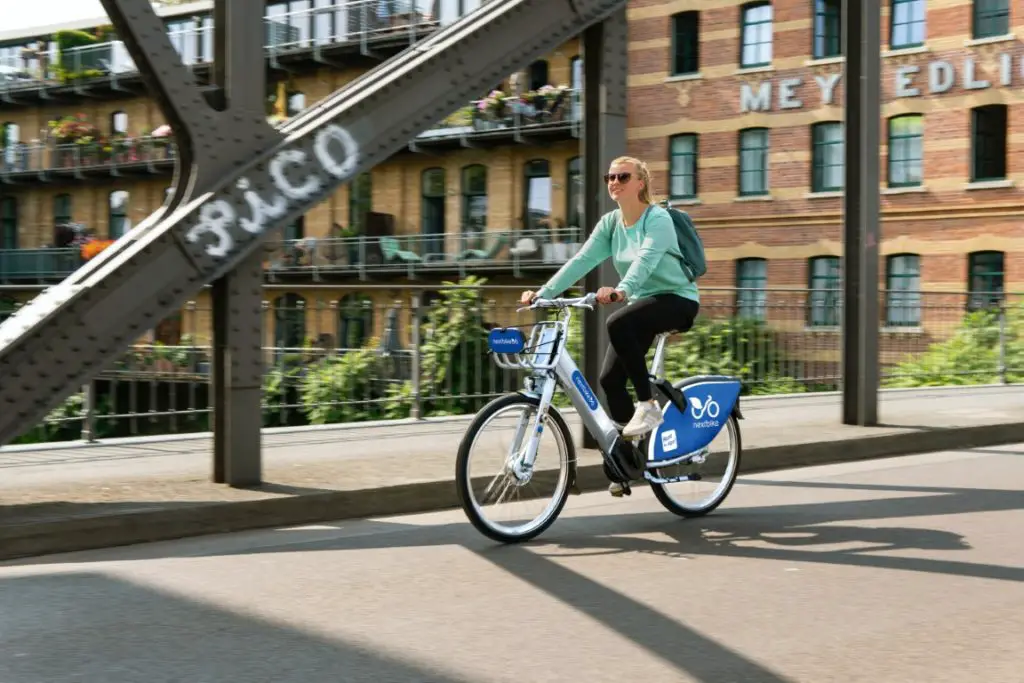Whether you’re a commuter and you want better air ventilation and less weight on your shoulders or you’re preparing for an upcoming bike tour, adding a rack to your bicycle opens up new possibilities. Adding a rack to the front or the rear of the bike may seem like a small choice, but in reality, it determines the way you ride your bike since they both have distinct characteristics. Let’s see what you need to know about front vs rear bike racks.
Front racks are better suited for lighter weights and on rough terrain, while rear racks are designed for heavier loads and are more convenient for riding in the city. Front racks are popular for bike touring to carry additional loads besides the rear rack, while commuters mostly use rear racks. Both front and rear bike racks are available for various riding styles.
Here’s a quick comparison table of front and rear bike racks from different angles.
| Rear Bike Rack | Front Bike Rack | |
| Handling | Easy with any weight | Easy with low weight |
| Wear on bike | Significant | Little |
| Typical weight limit | Up to 115 lbs | Up to 35 lbs |
| Steering | Easier | Harder |
| City handling | Easier | Harder |
| Climbing hills | Harder | Easier |
| Rough terrain handling | Harder | Easier |
| Heel clearance | Potential issues | No issues |
| Maneuverability | Easier | Harder |
| Parking bike | Easier | Harder |
| Stairs | Easier | Harder |
Before you add any bike rack to your bike it’s good to understand what each is best suited for. Of course, you can carry various things on either the front or the rear, but knowing how you’re going to use your bike and what loads you are going to carry is going to help you find the perfect way to pack.
Electric bikes built for everything and priced for everyone. Shop Rad Power Bikes, America's #1 electric bike brand. Get out. Go further. Ride Rad.
Rear Bike Racks
Reak bike racks are mostly designed to carry heavy weights for bike touring or grocery shopping, but they are also exceptionally good for commuting. You can attach things directly on top of them with bungee cords, you can use them to carry panniers or you can put a basket on them depending on your needs.
Here are some things you can carry on a rear rack:
- They are great for panniers, which is a popular choice among commuters who need to carry several items, such as a laptop, change of clothes, toiletries etc.
- Baskets. They are excellent to carry either several loose items placed directly in them or even to carry a backpack, laptop bag or messenger bag if you don’t fancy using panniers.
- Folding pannier style baskets can be attached to double or triple the cargo capacity of your regular baskets. This could prove very useful for trips down to the market or the grocery store.
- Use a bungee chord to strap things on the rack directly. You can carry your rain jacket, a small bag or backpack or a pizza.
- Some bike racks and panniers come as an integrated system so they can clip into each other easily.
- Attach a net, such as the Mundo AirPannier, which turns everything into a pannier, or any DIY net with some carabiners to the rack and carry things in it directly.

How Do Rear Bike Racks Mount?
They are more popular than front bike racks not only because they are better-known, but probably also because they are more versatile and practical for what most people need.
Most rear racks attach to the bike via four braze-ons located on the frame. You need to make sure that you get disc brake-specific racks if your bike has disc brakes.
If your bike doesn’t have braze-ons, you can use P-clamps to mount the rack to your bike frame. Saddle post-mounted bike racks are also useful if you can’t or don’t want to attach a “permanent” rear rack to your bike.

Types Of Rear Racks
Some rear racks are built to last and are designed with touring in mind, while others are perfect for lighter weights, such as commuting with a laptop and a change of clothes. Aluminum racks are lighter but they generally hold less weight and are less durable, while steel or Chromoly racks are heavier, more expensive, and they can hold a lot of weight and can take a lot of abuse. As a rule of thumb, you always choose the rack for the roughest conditions you expect to ride in.
- Standard racks. These racks are the racks found on most bicycles. They are good great for general purpose riding such as commuting, and you can also attach some weight to them for short weekend tours.
- Touring specific racks. They are heavy duty racks and often have two sets of rails to attach panniers to as well as the platform, which can carry other items, such as a tent or an extra bag. If you want to carry extra heavy loads, go for a steel or chromoly rack as they will be more durable.
- Seatopost racks without guard rail. They are simple and useful if you intend to put a basket on your rack or strap some light stuff directly onto the rack, but they aren’t suitable to carry panniers since there’s nothing to stop the pannier from touching the wheel. Thet also have a low weight limit since they attach to the saddle post.
- Saddlepost racks with guardrail. These mount to your bike’s saddlepost, and they can carry things not attached to the top, but you can also add panniers to them. Some have additional stabilizing rods for an increased weight limit of up to 115 lbs, which is pretty impressive even for a touring rack.
Rear Bike Rack Pros
More carry capacity than front racks
The average weight capacity of a rear bike rack is 55 lbs, which is significantly more than the 35 lbs capacity of an average front bike rack.
Easier to maneouver
You can load up your rear rack with a ton of weight, and you can still easily steer your bike at any speed. This is great for commuting.
Easier to lift your bike
If you need to carry your bike up stairs you will appreciate rear racks. You can put a bike with a loaded rear rack on your shoulders, and you should be fine. This is much more difficult with a loaded front rack.

Rear Bike Rack Cons
Potential heel clearance issues
Some bikes have short chainstays, which means that the center point of the pedal (bottom bracket) is close to the hub of the rear wheel. Road bikes typically fall into this category. Heel clearance can become an issue when you mount panniers on a rear rack especially if you have large feet and large panniers.
Hybrid bikes, touring bikes and trekking bikes are designed to carry stuff on the rear rack, and you are less likely to experience heel strike when using panniers.
On bikes with little heel clearance, you can look for an adjustable rack that has some fore-aft movement so you can push the pannier as far back from your heel as possible.
Standing out of the saddle is harder
When I first loaded my rear rack with over 25 lbs of weight in my pannier, I found this very strange. It changed how riding uphill felt, especially when I stepped out of the saddle to climb a hill because the rear of the bike wants to stay in the center. This is less of an issue if you carry the load on the front of the bike.
Harder to access bag contents
With a rear rack, you always have the cargo behind you, which means that there is no quick access to your phone or to any other item you carry there. If you have a basket or a randonneur bag mounted on the front of the bike, this gives easy access to everything inside. Of course, if you want to access anything in the pannier on your lowrider front rack, you still have to get off the bike.
Front Bike Racks
Front racks are also used for touring or bike packing and there is a wide scale of different types of front racks. Depending on their style, you can attach panniers or bags to them directly, or you can mount items on them too.
Front basket racks are well-liked among bike commuters, especially for shorter rides and on Dutch-style city bikes. The main convenience is that you have your bag and cargo right at your fingertips, so you have immediate access to your phone, keys, or snacks.
Here are some things you can carry on a front rack:
- Panniers (these are best carried in pairs to maintain balance)
- Randonneur bags containing small items such as phone, snacks, camera etc.
- Small items strapped directly to the rack (e.g. sleeping bags, tents)
- Front basket to hold loose items or a bag/backpack.

How Do Front Racks Mount?
Similar to rear bike racks, most front racks also mount to the bicycle via braze-ons. If your front fork has holes, chances are that you can attach a front rack to your bike. If your bike has no braze-ons, you can also use P-clamps to attach a front rack.
Also, there are some front racks made specifically for bikes with front suspension. They attach to the lower part of the fork, which means that the suspension is not affected.
Types Of Front Racks
- Low riders attach to your front fork via the eyelets and they allow you to carry panniers. They are very useful for bike touring.
- Randonneur racks. These racks take smaller bags you want to carry on the front, but they don’t take panniers. They are small racks for smaller items such as cameras or snacks.
- Basket racks are excellent for mounting a front basket for placing items directly.
Pros Of Front Bike Racks
No heel clearance issues
Since the rack is mounted in front of you, you never have to worry about hitting your panniers with your heels.
Safety
If you want to keep an eye on your stuff at all times even when riding in the traffic and stopping at red lights, front racks allow you to do just that. You don’t need to turn around to see whether anyone has tampered with your bag.
Quick access
With your things being mounted on the front, you can get quick access to anything you may need. Randonneur bags, or front baskets are particularly practical to grab a camera, snacks, phone or other handy items.
Maneuvering on rough terrain
With a fully loaded pannier on the rack, it’s easier to handle the bike off-road if it’s mounted on the front than it is when mounted on the rear rack.
Cons Of Front Bike Racks
Need to balance weights
A major downside of front bike racks that are designed to carry panniers is that the load needs to be balanced pretty evenly between the two sides. Uneven weight distribution affects bike handling and makes it less pleasant of a ride. This means that front racks are better suited for touring than commuting since you carry more stuff on a bike tour than on a bike commute.
This isn’t an issue if you use a smaller bag on top of the rack.
Affects steering
A heavily loaded front rack can affect how your bicycle steers. It changes your bike’s behavior in corners. Also, if you tend to lift both of your hands off the handlebar and ride no-handed, it’s going to be impossible with a loaded front rack. It’s probably not a deal-breaker for most people, but something definitely to keep in mind.
Maneuvering urban roads
This is a big limitation of front racks since you’re not as nimble on the bike. Potholes, train or tram tracks, cobblestone, getting on curbs are all enemies of heavily loaded front racks. If you encounter these on your rides, you’re much better off with a rear rack.
Which one should you choose?
Whether a front or a rear rack best suits your needs depends on your objective and your riding style.
If you’re a commuter or you just want great control over your bicycle when riding, a rear rack is a better option for you. If you go on a tour with some challenging terrain, front racks are better suited. Either way, you will have to make some compromises because no rack can do it all.
You may find yourself in a situation where you need both of them.
Or just give both of them a go and decide for yourself.
Happy pedaling!
